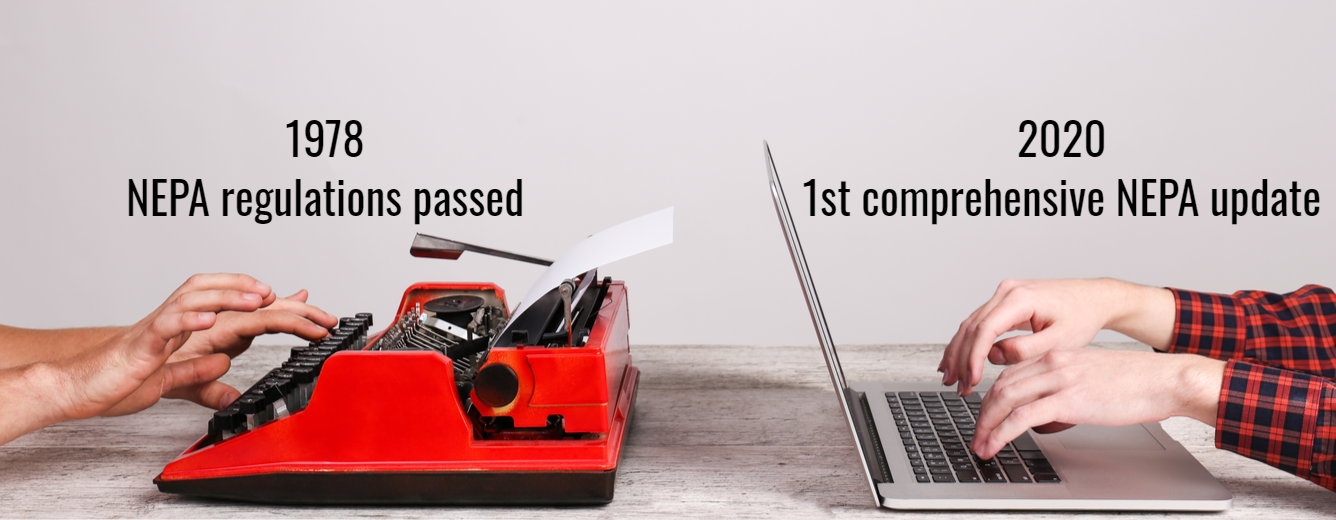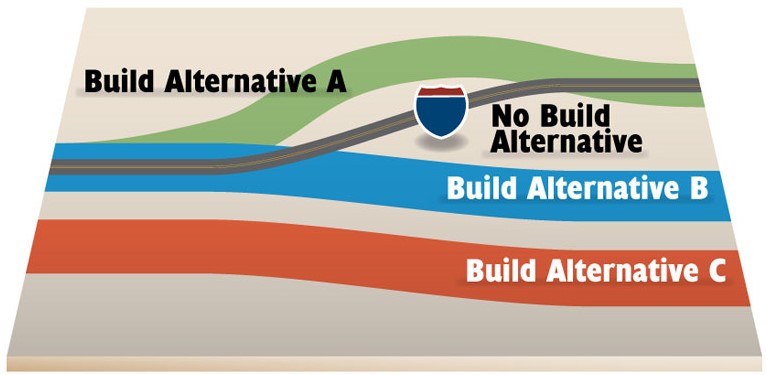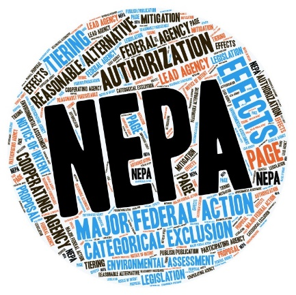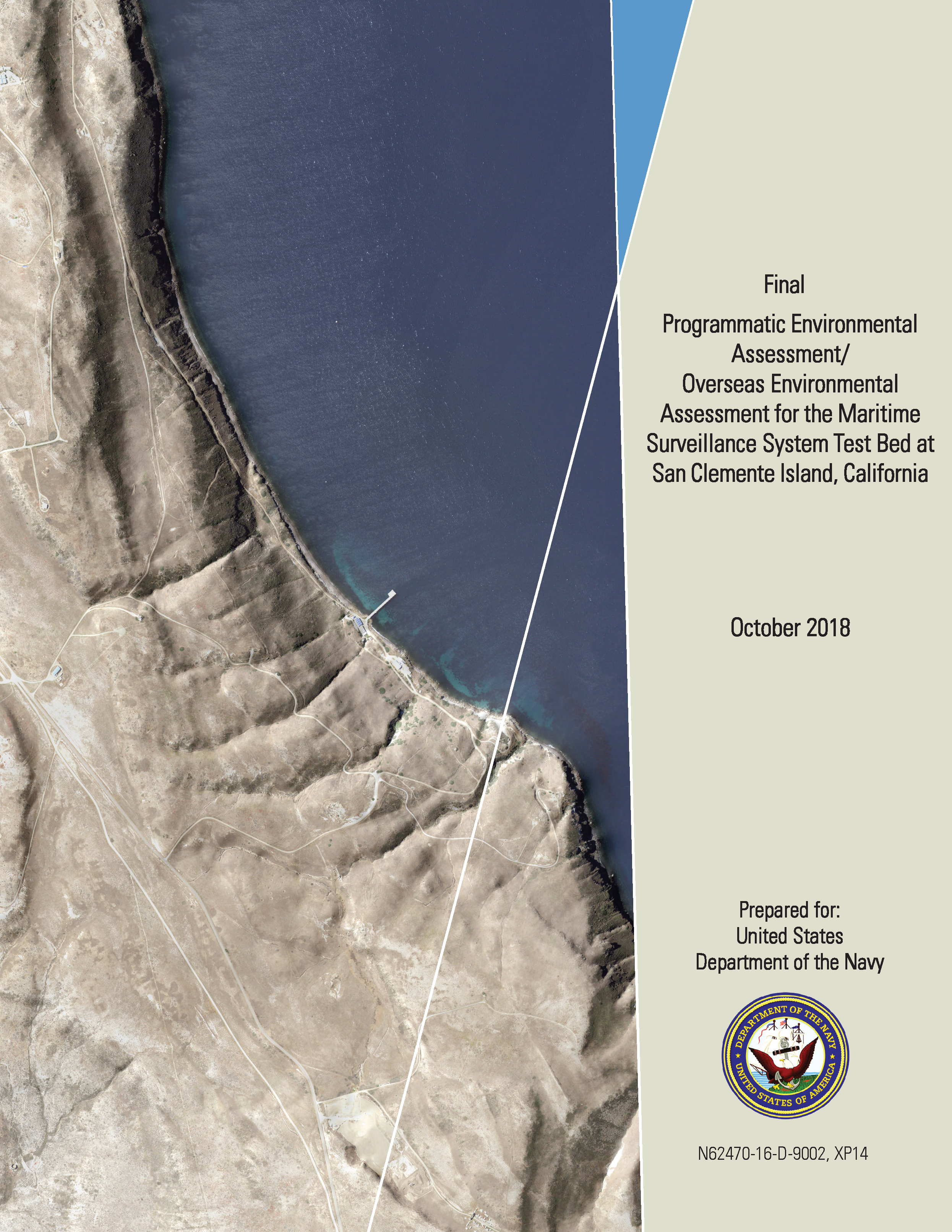A number of recent articles have alarming headlines implying that President Trump is rolling back environmental requirements. They are referring to the latest proposed changes to the National Environmental Policy Act (NEPA). Tempting as it may be to get wrapped up in headlines, I took a closer look at the proposed changes to the NEPA regulations that were published on January 10, 2020. The proposed NEPA changes actually reveal changes that have been in the making for many years and over several different administrations. Bottomline, this environmental regulation is not going away and it will still provide for the public to get involved and voice concerns about proposed Federal projects.
NEPA regulations were initially passed over 40 years ago. While there has been numerous guidance issued and a large body of NEPA case law, there hasn’t been a comprehensive NEPA regulation update until now.
So, here is a summary of my “top ten” key takeaways of the proposed NEPA changes, how this affects Federal agencies and how we do NEPA daily, and what’s next.
 Why are NEPA regulations being updated?
Why are NEPA regulations being updated?
NEPA regulations can be challenging, and the process lengthy, costly, and complex. In fact, studies show the average time for completion of an Environmental Impact Statement (EIS) was over 4.5 years and an average of 586 pages.
In August 2017, President Trump issued an Executive Order to establish a streamlined process for infrastruct
ure projects such as oil and gas projects. As a result, the governing agency of NEPA, the Council on Environmental Quality (CEQ) published an initial list of actions including identifying potential revisions to update NEPA regulations.
In June 2018, CEQ asked the public and agencies to comment on how CEQ could clarify the NEPA process; they received a whopping 12,500 comments. The vast majority of comments appear to be pre-written form letters from environmental organizations, and supporters of parks and avid outdoor recreationists. But there were also quite a number of comments from Federal agencies that we at Scout Environmental work with, such as the Department of Defense (DoD) and the General Services Administration (GSA) to name a few.
 What are the key takeaways from the NEW proposed NEPA regulations?
What are the key takeaways from the NEW proposed NEPA regulations?
Let me start by noting that in the proposed changes, the background and legislative history takes 28 of the total 47 pages published in the Federal Register. CEQ asks repeatedly for specific responses about how to “clarify” its intent in the regulations.
There are quite a number of proposed changes, but these are the top ones that might be of most interest to our Federal clients such as DoD, GSA, the U.S. Department of Veterans Affairs, and the U.S. Geological Survey. Let’s look at how it might affect how we do NEPA on a daily basis as a team.
1. Removes the requirement for separate discussions of cumulative, direct,  and indirect effects.
and indirect effects.
To say this is a “HUGE” deal is an understatement. There are entire NEPA courses just on how to do cumulative impact analyses. Up until this point, all NEPA analysis not only includes the potential impact of the proposed action but also the potential impact of the proposed action combined with environmental impacts of past, present, and likely future projects. While this could be a big time saver in evaluating the proposed project and reducing the number of pages, this is a huge shift in NEPA analysis and has been a major basis for litigation. It would also fundamentally ignore the very real effects from cumulative actions.
According to CEQ, while NEPA refers to environmental impacts and environmental effects, it does not subdivide the terms into direct, indirect, or cumulative which has caused confusion and litigation. CEQ proposes to simplify the definition of effects by striking the specific references to direct, indirect, and cumulative effects. CEQ proposed revisions are intended to focus agencies on consideration of effects that are reasonably foreseeable and have a reasonably close causal relationship to the proposed action.
What this means for you?
Pros: For Federal agencies, this would help to cut the length and time of analysis. Looking at one recent draft EIS that was over 1,300 pages due to multiple locations, the cumulative impacts sections were approximately 75 pages. While that doesn’t seem to make a big dent in the size of the document, the time to do the cumulative analysis may make a difference to the timeline.
Cons: On the flip side, not including a cumulative impact analysis may not accurately reflect the potential combined effects of other projects in the area. That is a tough one to get around especially for large scale oil and gas projects with the potential to significantly add to greenhouse gas emissions if other similar projects are proposed or ongoing within the same area.
2. Adds page and time limits for EAs and EISs
CEQ proposes page limits for an Environmental Assessment (EA) at 75 pages, not including appendices. An EA can be longer with the written approval of the “senior agency official,” who must be at the Assistant Secretary level or equivalent. The number is 150 pages for an EIS and up to 300 pages if the EIS is complex, with the same exception for the senior agency official to allow more pages, if needed.
The EA must be completed within 1 year and the EIS 2 years, from the public notice of beginning the EIS (Notice of Intent) to the final decision document (Record of Decision). This too can be modified with senior agency approval. In addition, they define a “page” as 500 words to ensure uniformity in document length….graphs and pictures don’t count towards the word count.
What this means for you?
Pros:
- Page limits: EAs and EISs can vary in size depending on the potential environmental impacts. This can be particularly challenging when draft EISs average 586 pages in total according to a 2019 CEQ study. This is where the streamlining process includes steps as incorporating links to reference studies that are publicly available and being concise on what environmental resource areas need to be analyzed in detail may save pages. CEQ is also attempting to help this streamlining process by further
- clarifying how impacts are defined (discussed below);
- removing the requirement to list the persons to whom copies of the EIS are sent;
- allowing for combining of affected environment and environmental consequences sections (already being done by many agencies).
Cons:
- Page limits: I’m unaware of any studies regarding the average length of EAs and wonder how the proposed page limit of 75 pages was determined. With EAs that we’ve helped develop and finalize, they have averaged approximately 70 pages primarily for DoD, GSA, and VA clients. For other agencies or actions, that number might not be sufficient.
- Start of the EA clock: In the proposed changes for EAs, the one year is measured from the date of decision to prepare an EA to the publication of a final EA. CEQ doesn’t provide a definition for the “date of decision to prepare an EA”. Some may interpret that the clock starts at the EA kickoff meeting; others may interpret the clock to start with a clearly defined proposed action or the completion of the Description of the Proposed Action and Alternatives (Chapters 1 and 2 of an EA/EIS).
- Consultation process: The long pole in the tent when it comes to most EAs and EISs is the consultation process. Another gap in the time limit for EAs and EISs is factoring the potential backlog with review by other agencies such as the U.S. Fish and Wildlife Service or the State Historic Preservation Office. There’s not an easy answer. Bottomline, this is where good ‘ol communication and coordination is needed to ensure those agencies have a heads up about upcoming projects. Preparing focused and complete documents will also facilitate a timely review and response.
3. New definition of “reasonable alternative”
The foundation of an EA and EIS is not only looking at the potential environmental impacts of what an agency would prefer to do, but also to analyze the potential environmental impacts of reasonable alternatives. How an agency determines the alternatives to be analyzed in their NEPA document is one of the most common challenges in substantive cases. For example, 11 of the 25 recent substantive NEPA decisions involved challenges to the sufficiency of the alternatives considered (NAEP Annual NEPA Report 2017).
CEQ is proposing that documenting alternatives in an EA would continue to be more limited than EIS requirements. Specifically, CEQ states that an agency does not need to include a detailed discussion of each alternative in an EA, nor does it need to include any detailed discussion of alternatives that it eliminated from study.
Whereas for EISs, the new definition of “reasonable alternative” would require the following new items:
- Alternatives must be technically and economically feasible and meet the purpose and need of the proposed action;
- Include a reasonable range of alternatives and not be required to give detailed consideration to alternatives that are infeasible, ineffective, or inconsistent with the purpose and need for agency action;
- Must consider the goals of the applicant when the agency’s action involves a non-Federal entity.
What this means for you?
Pros: The proposed changes help to clarify how agencies should differentiate alternatives. And for EISs, this new definition can be helpful to Federal agencies when the public suggests consideration of alternatives that are not technically or economically feasible.
Cons: Agencies will have to do their due diligence to show that an alternative is technically and economically feasible.
4. Clarifies and adds approximately 20 NEPA terms
There is an extensive body of case law interpreting NEPA. CEQ recognizes that a “challenge for agencies is that courts have interpreted key terms differently […] adding to the complexity of environmental reviews.” So, to help clarify the different interpretations of key terms, CEQ proposes to modify, add, and delete approximately 20 NEPA terms.
CEQ received many comments on the definition of “major Federal action” which draws the line in the sand whether an agency needs to comply with NEPA. As a result, CEQ is proposing to clarify that an action meets the definition if it is subject to “Federal control and responsibility, and it has effects that may be significant.”
One of those new terms, “exhaustion” is to specifically reinforce that parties may not raise claims based on issues they did not raise during the public comment period and have 30 days after the final EIS to object to any summary of their comments.
What this means for you?
Pros: Some of the modified terms provide more clarity on CEQs intention on the implementation of NEPA.
Cons: The big one is the changed definition of effects and how that limits the impact analysis to exclude cumulative impacts. Having new and clarified NEPA terms means your NEPA team must be fully up to speed on the new language and the attendant definitions to ensure compliance and consistency in interpreting these new terms.
5. Expands Categorical Exclusions
One of the major initiatives will be to expand the use of categorical exclusions. The proposed regulations go so far as allowing one Federal agency to use another Federal agencies’ categorical exclusions, if they don’t already have one themselves that is applicable to the proposed action.
What this means for you?
Pros: You may be able to use categorical exclusions that weren’t previously included in your agency’s list of categorical exclusions and may help to streamline your NEPA review process. This would also save agency time in updating their list of categorical exclusions. The Department of the Army currently has proposed changes to their categorical exclusions out for public comment until February 18, 2020 and these might offer an expanded list for other agencies to consider once both the NEPA and Army regulations are finalized.
Cons: If CEQ proposes government wide categorical exclusions (which at this time CEQ is merely inviting comments on this one), it might not work for all agencies since they develop and support categorical exclusions based on their historic experience.
6. Adds the option for Programmatic EAs to tier an EA or EIS
CEQ proposes a new paragraph to address tiering to make clear that agencies may use EAs at the programmatic stage as well as the subsequent stages.
What this means for you?
Pros: This change could make clear that a site-specific EIS may correctly tier from a programmatic EA, when implementation of a program without significant effects at a national level may have a significant impact at a local scale.
Cons: I don’t personally see any cons to a programmatic approach if it fits the situation. We’ve developed programmatic NEPA documents before and they’ve served our clients well.
7. Allows mitigated FONSIs but needs legal basis
Another interesting addition is the proposal to clarify how the EA decision document – the Finding of No Significant Impact (FONSI) – addresses mitigation measures. Specifically, where mitigation is required under another statute, or where an agency is issuing a mitigated FONSI (which means the agency decided to implement measures to minimize the potential environmental impact that would otherwise require preparation of the more extensive EIS). This proposed change isn’t intended to create a different standard but to provide clarity regarding the use of mitigated FONSIs.
What this means for you?
Pros: From an environmental perspective, it is a good thing to ensure that agencies have the resources and can commit to the mitigation measures identified in a final decision document. It ensures Federal agencies will fully implement mitigation and enables transparency to the public.
Cons: This means as a Federal agency if you intend to sign a mitigated FONSI, you’ll need to meet a higher bar: commit to those mitigation measures, identify sufficient legal authority, and commit that you’ll have the resources available to implement the mitigation measures.
8. Adds requirement to include the estimated NEPA costs on the cover of  EISs
EISs
CEQ is also proposing to include on the cover of the EIS, the estimated total cost of preparing the EIS, including the costs of agency personnel hours, contractor costs, and other direct costs This addresses concerns raised by the U.S. Government Accountability Office that agencies are not tracking the costs of NEPA and provides transparency to the public regarding EIS-level NEPA costs.
What this means for you?
Pros: As a Federal agency, you’re likely already tracking how much it costs for contractors to assist you with developing EISs but…
Cons: …now all hours spent by Federal employees should be accounted in that overall cost. That can be tricky if you are the lead agency and trickier if you also need to include cooperating agencies.
One of the gaps is whether this should include all the time by other agencies as part of the consultation process which may be a time consuming and burdensome process.
Another gap is whether the estimated cost on the cover should include cost to date if publishing a draft EIS or whether it should only be included on the final EIS. While CEQ would provide flexibility for agencies to develop methodologies for preparing these cost estimates, it may be a challenge in resources ahead.
9. Considering adding a requirement on the maximum number of alternatives to be analyzed
Okay now, this one isn’t a proposed change – yet – but CEQ is specifically asking whether they should establish a “maximum number of alternatives” such as limiting the analysis to three alternatives. CEQ recognizes that the discussion of environmental effects of alternatives does not have to be exhaustive.
What this means for you?
Pros: From a Federal agency’s perspective, limiting the alternatives to be analyzed to no more than three might be helpful to significantly cut time and length in the NEPA process.
Cons: Multi-site projects may not be accurately evaluated, resulting in litigation. For example, we’ve worked on DoD EISs that included more than three alternatives because of multiple locations of the proposed action and if that number would have been applied to the proposed project, it would have been challenging to do a comprehensive environmental impact analysis of the proposed action.
10. For EISs, adds a new section to include a summary of alternatives, information and analysis submitted by the public for consideration
While CEQ is streamlining some portions of the NEPA process, here’s an addition that would add an entirely new section in draft and final EISs…to include a summary of all alternatives, information, and analyses submitted by the public for consideration by the lead and cooperating agencies. It appears to be an attempt to button up the public’s ability to raise claims on issues they did not raise during the public comment period.
What this means for you?
Pros: With EISs that we’ve been involved with, this isn’t entirely a new effort. Depending on the project, this might have been information we were already summarizing but throughout the document and this would now have a particular section heading.
Cons: This means a new section in your EISs and additional effort to summarize information received from the public. We have in the past summarized public comments and mentioned alternatives that were raised and considered or eliminated.
 What stays the same?
What stays the same?
In addition to noting what is proposed to change, it’s important to note what won’t change … agencies are still required to identify potential environmental effects in adequate detail and involve the public. The foundation of the NEPA process remains solid.
For example, for EAs the proposed regulations would continue to provide Federal agencies the flexibility to conduct public involvement tailored to the interested public and to particular circumstances to provide meaningful input. CEQ is expanding agencies flexibility so that agencies can begin the public involvement process (sometimes referred to as pre-scoping) as soon as the proposed action is sufficiently developed for meaningful agency consideration.
The biggest takeaway what’s not changed are the plethora of other environmental laws that Federal agencies still need to comply with such as the Endangered Species Act, the Clean Air Act, Clean Water Act, and the National Historic Preservation Act to name a few. Remember, NEPA is considered an umbrella policy because multiple laws are considered as part of the NEPA process, but these laws are enforceable on their own.
 What’s next?
What’s next?
These proposed NEPA changes are not a done deal and this is not an exhaustive list of all the proposed changes. The proposed NEPA changes are out for review and public comment until March 10, 2020. Then CEQ will need some time to review, categorize, and consider the comments, which may take a few months. At that time, CEQ may finalize the proposed regulations as is or modify the proposed changes to address comments.
- What can you do/How can you comment?
You can attend public hearings which will be held in Denver and Washington, DC on February 11 and February 25, respectively but you have to register in advance. You can submit comments as an individual or work with your agency at the appropriate headquarters level to provide feedback from your perspective. Comments can be submitted online here (reference docket number CEQ-2019-0003).
- When will the regulations be effective once finalized?
All new NEPA started after the final publication date would need to adhere to the new NEPA regulations. Interestingly, agencies would have the option to apply the new NEPA regulations to in-progress documents. My guess is we won’t see final approved regulations until perhaps late summer/early fall depending how extensive the comments are.
- Do Federal agencies have to update their NEPA policies?
Yes, but not yet. Agencies would have 1 year to develop or revise agency NEPA policy once CEQ finalizes these changes. That may not be a sufficient amount of time for some particular agencies. And for those agencies that are new, such as Space Command, they would only have 9 months to prepare their new NEPA regulations once these have gone final.
- Will previous CEQ guidance still be applicable?
Definitely not. CEQ clearly states its intent that the proposed NEPA revisions once finalized will replace all previous CEQ guidance.
We’ll continue to monitor the proposed revisions and keep you in the know. Contact us today to help simplify your NEPA process and navigate the complexities of these upcoming changes: melanie.hernandez@scoutenv.com



 Why are NEPA regulations being updated?
Why are NEPA regulations being updated?
 What are the key takeaways from the NEW proposed NEPA regulations?
What are the key takeaways from the NEW proposed NEPA regulations? and indirect effects.
and indirect effects.



 EISs
EISs What stays the same?
What stays the same? What’s next?
What’s next?










